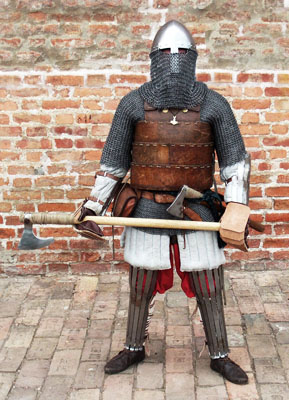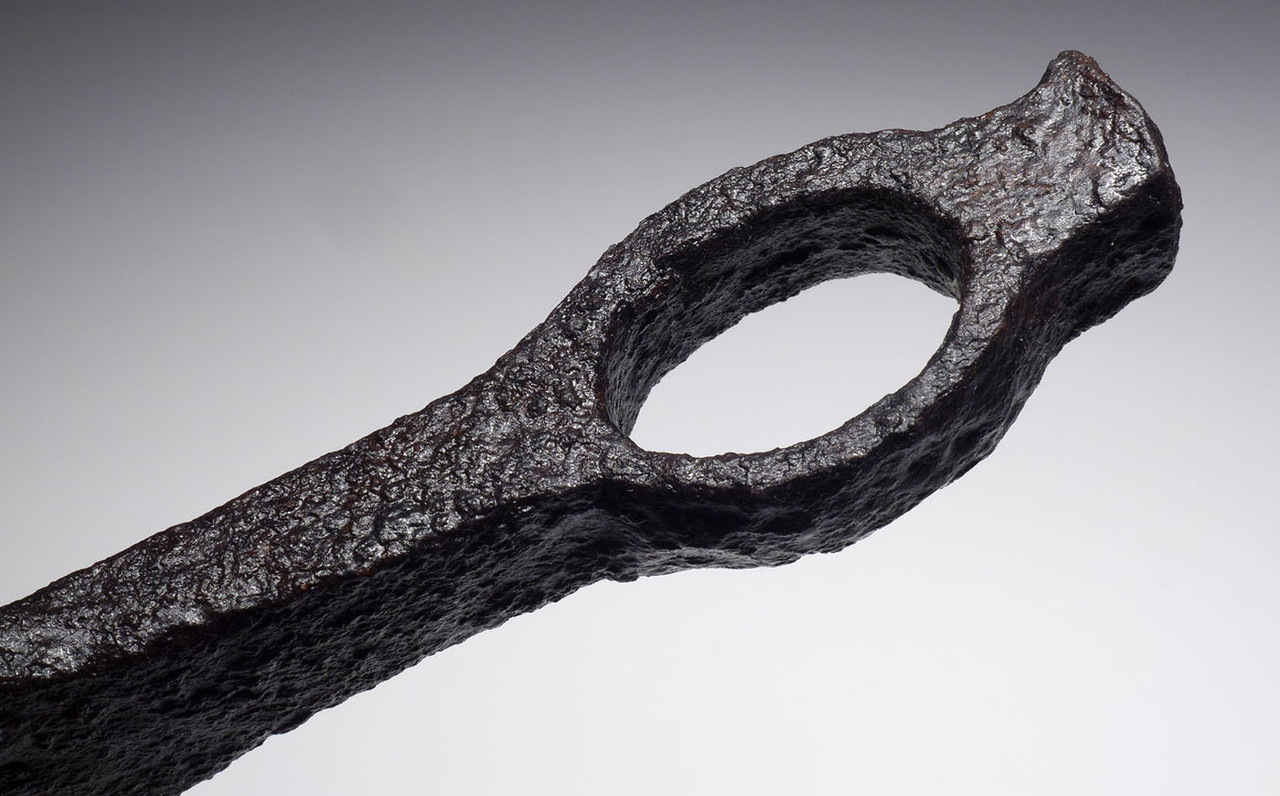Product Description
SEE MORE ANCIENT ROMAN ARTIFACTS
In the Byzantine Roman ancient world, there was one fighting force that relied on the axe as a primary weapon - the fearless and highly feared Varangian Guard of the Roman Byzantine military. These were the elite shock troops and personal body guards to the emperor. In battle, they were employed on the front lines to break enemy advances, wielding intimidating large two-handed shaft axes on long handles. They carried a second heavy axe in their belt for back-up, on a shorter handle.
This is a rare Viking halber axe that was used as a secondary personal weapon, worn in a belt. It is in excellent preservation and complete with no damage. Despite its reduced size, the broad cutting blade would have inflicted massive cuts to enemy soldiers. The shafthole shows how large the handle would have been, confirming this as being a one-handed belt axe. The hammer butt end would have been effective in crushing the skulls of helmeted enemies. The halberd axe was a typical war axe from the Scandinavian tribes of the Vikings who were the most feared warriors of the Varangian Guard. This axe would have been employed as a secondary backup weapon for fighting in extreme close quarters. The fantastic preservation has yielded all style details in full as originally made which is very rare for ancient iron from Europe!
When fighting got close and personal, the axe was a devastating weapon and could defeat all forms of armor. The axe required no skill or special training, and could inflict fatal wounds with a single blow, making it one of the most deadly of all ancient weapons. The most feared infantry soldiers of the Byzantine Roman army were the Varangian Guard shock troops, famous for fighting on foot with large iron axes.
This weapon was used by the Byzantine Christian Roman armies defending the Empire's northern border along the Danube River in the present day East Balkans. This region was the northern-most boundary of the Roman Empire for most of its duration and evolution into Byzantium until 1336 AD, when the area fell under Ottoman rule. In the Balkans, Roman camps and fortresses along the Danube were constantly being challenged by opposing tribes and armies. The river served as a natural barrier against attacks from the north. Collected from a region that was once occupied by the Byzantine Roman military as they fought against the challengers of the Christian Roman Empire, these weapons were utilized by Roman soldiers in one of the many violent and frequent battles that took place in defense of Byzantium.
NOTE: This genuine artifact has been professionally cleaned and conserved in our museum lab facility to ensure against further deterioration. Unlike most metal artifacts sold on the market that are untreated and uncleaned, ALL our specimens our properly cleaned, inspected and conserved in our museum conservation lab prior to being offered for sale to our clients. The vast majority of sellers of metal artifacts do NOT PROPERLY conserve their specimens and many do nothing at all. If metal artifacts are NOT treated and stabilized correctly, THEY WILL CONTINUE TO CORRODE AND COULD EVENTUALLY FALL APART.
HISTORY
 The Varangian guard in the Byzantine Roman military, were known for their love of the vine, for their loyalty to the Emperor, and for their bravery in battle. The battle axe was the principal weapon of the Varangians, as recorded in the sources (Psellos, Chronographia, VI, 87 ; Anna Komnena, Alexiadis, II, 9, p. 120-IV, 6, p. 116; Choniates, Cronikh dihghsis I, 5.). These special warriors were composed of recruits from outside of Byzantium by design. Made up of fierce fighters from northern Europe including Norsemen from Scandinavia, and Anglo-Saxons from England, they lacked local political loyalties and could be counted on to suppress revolts by disloyal Byzantine factions.
The Varangian guard in the Byzantine Roman military, were known for their love of the vine, for their loyalty to the Emperor, and for their bravery in battle. The battle axe was the principal weapon of the Varangians, as recorded in the sources (Psellos, Chronographia, VI, 87 ; Anna Komnena, Alexiadis, II, 9, p. 120-IV, 6, p. 116; Choniates, Cronikh dihghsis I, 5.). These special warriors were composed of recruits from outside of Byzantium by design. Made up of fierce fighters from northern Europe including Norsemen from Scandinavia, and Anglo-Saxons from England, they lacked local political loyalties and could be counted on to suppress revolts by disloyal Byzantine factions.
The Rus' provided the earliest members of the Varangian Guard. They were in Byzantine service from as early as 874. The Guard was first formally constituted under Emperor Basil II in 988, following the Christianization of Kievan Rus' by Vladimir I of Kiev. Vladimir, who had recently usurped power in Kiev with an army of Varangian warriors, sent 6,000 men to Basil as part of a military assistance agreement.
The Varangian Guard not only provided security for the Byzantine emperors, but also participated in many wars, often playing a decisive role. The Varangian Guard was only used in battle during critical moments, or where the battle was most fierce and at the risk of defeat. Ancient Byzantine writers recorded with a mix of terror and fascination that the "Scandinavians were frightening both in appearance and in equipment, they attacked with reckless rage and neither cared about losing blood nor their wounds". The description probably refers to berserkers, since this state of trance is said to have given them superhuman strength and no sense of pain from their wounds. By the late 13th century, Varangians were mostly ethnically assimilated by the Byzantine Greeks, though the Guard remained in existence until at least mid-14th century. In 1400, there were still some people identifying themselves as "Varangians" in Constantinople.
The Varangians relied on the broad-bladed Dane axe as their main weapon, although they were often also skilled swordsmen or archers. In some sources, such as Anna Komnene's The Alexiad, they are described as mounted; both Vikings and elite Anglo-Saxon warriors routinely used horses for strategic mobility even though they normally fought on foot. The Guard was stationed primarily around Constantinople but also accompanied armies into the field, and Byzantine chroniclers (as well as several notable Western European and Arab chroniclers) often note their battlefield prowess, especially in comparison to the local barbarian peoples. They were vital to the Byzantine victory under the emperor John II Komnenos at the Battle of Beroia in 1122. The Varangians hacked their way through the enemy's circle of Pecheneg wagons, collapsing the Pecheneg position and causing a general rout in their camp.
 US DOLLAR
US DOLLAR
 EURO
EURO
 AUSTRALIAN DOLLAR
AUSTRALIAN DOLLAR
 CANADIAN DOLLAR
CANADIAN DOLLAR
 POUND STERLING
POUND STERLING












